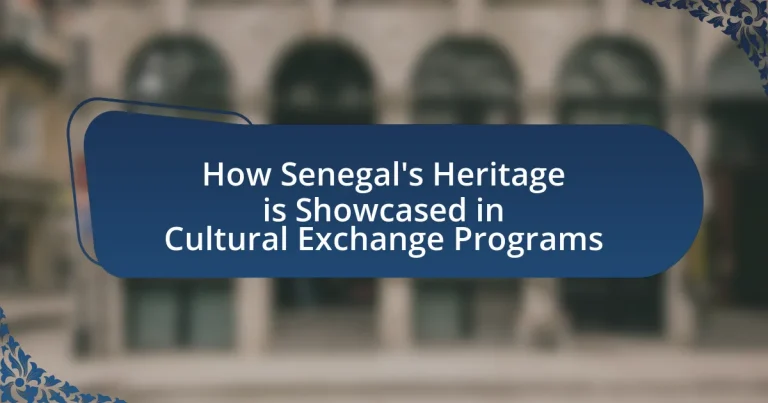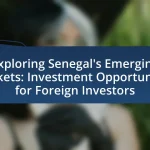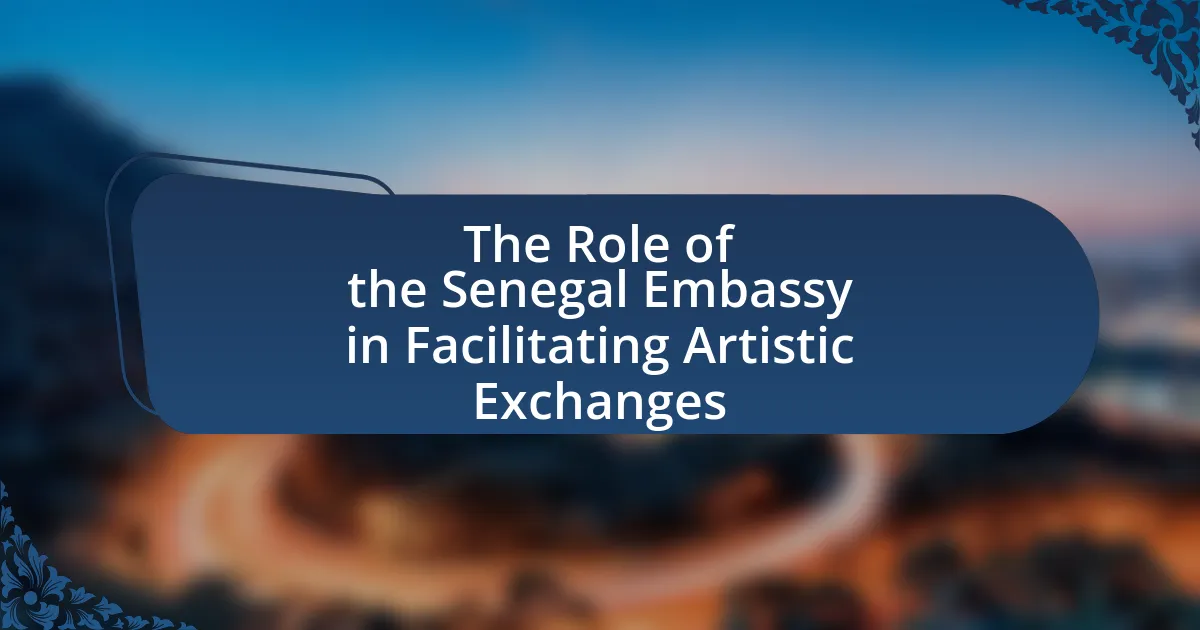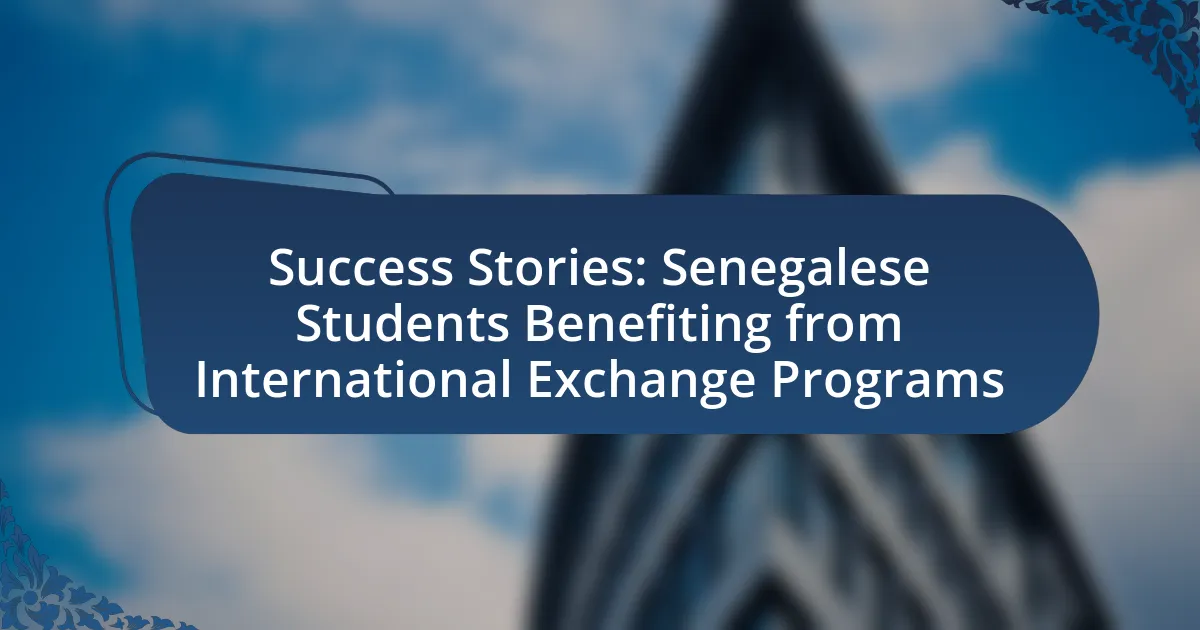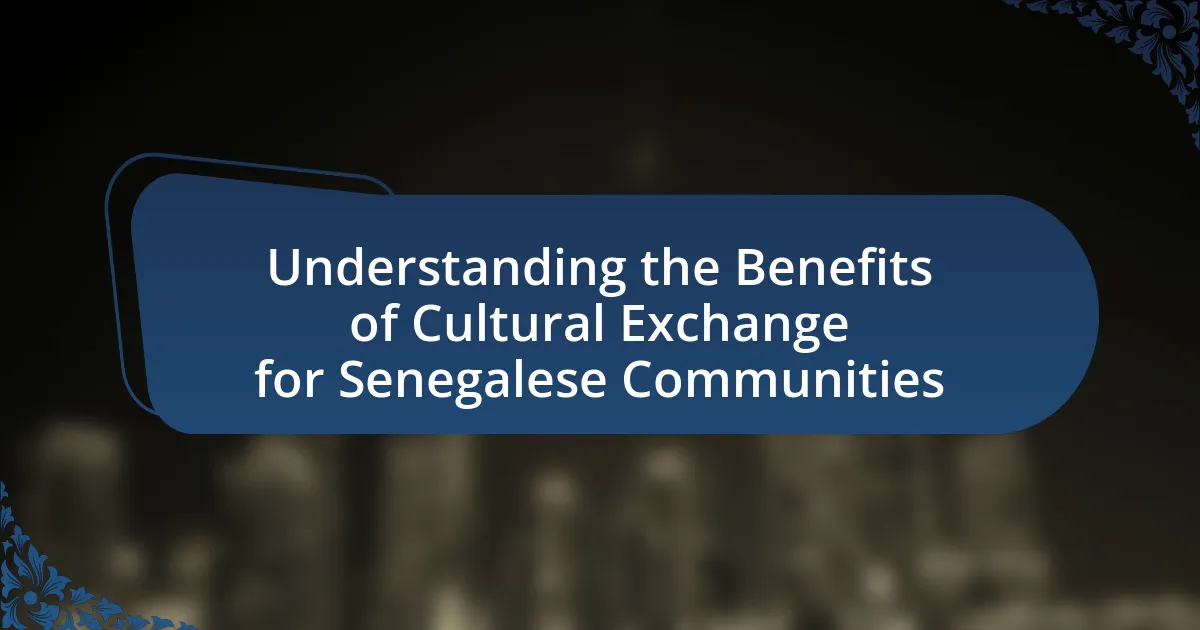Senegal’s heritage is prominently showcased in cultural exchange programs that emphasize traditional music, dance, art, and culinary practices. These programs feature Senegalese artists and cultural practitioners, highlighting key elements such as the vibrant rhythms of sabar drumming, intricate textile designs, and the significance of griots in preserving oral history. Through workshops, performances, and international partnerships, these initiatives foster mutual understanding and appreciation of Senegal’s diverse cultural identity, while also enhancing the country’s global image and promoting economic opportunities in tourism and cultural industries. Additionally, educational exchanges and community development initiatives play a crucial role in enriching cultural understanding and providing Senegalese youth with valuable experiences.
How is Senegal’s Heritage Represented in Cultural Exchange Programs?
Senegal’s heritage is represented in cultural exchange programs through the promotion of traditional music, dance, art, and culinary practices. These programs often feature Senegalese artists and cultural practitioners who showcase the country’s rich history and diverse cultural expressions, such as the vibrant rhythms of sabar drumming and the intricate designs of traditional textiles. For instance, the “Senegalese Cultural Exchange Program” has facilitated workshops and performances that highlight the significance of griots, who are traditional storytellers and musicians, thereby preserving and sharing Senegal’s oral history. Additionally, partnerships with international institutions enable Senegalese culture to reach a global audience, fostering mutual understanding and appreciation of its unique heritage.
What are the key elements of Senegal’s cultural heritage?
The key elements of Senegal’s cultural heritage include traditional music, dance, art, cuisine, and oral literature. Traditional music, exemplified by genres like mbalax, incorporates various instruments and rhythms that reflect Senegal’s diverse ethnic groups. Dance forms, such as the Sabar, are integral to celebrations and rituals, showcasing community and identity. Senegalese art, particularly in textiles and sculpture, often features vibrant colors and intricate designs that convey cultural narratives. The cuisine, characterized by dishes like thieboudienne (fish and rice), highlights local ingredients and culinary practices. Oral literature, including storytelling and proverbs, preserves history and values, reinforcing social cohesion. These elements collectively illustrate the rich tapestry of Senegal’s cultural identity and are often highlighted in cultural exchange programs to promote understanding and appreciation of Senegalese heritage globally.
How do traditional music and dance reflect Senegal’s heritage?
Traditional music and dance in Senegal reflect the country’s heritage by serving as vital expressions of its cultural identity, history, and social values. These art forms are deeply rooted in Senegalese traditions, often passed down through generations, and are integral to ceremonies, celebrations, and communal gatherings. For instance, the Sabar dance, accompanied by traditional drumming, is not only a form of entertainment but also a means of storytelling and preserving historical narratives. Additionally, the use of instruments like the kora and djembe highlights the significance of oral traditions and the role of music in community bonding. This cultural richness is showcased in various cultural exchange programs, where Senegalese music and dance are shared globally, promoting understanding and appreciation of Senegal’s diverse heritage.
What role do art and crafts play in showcasing Senegal’s culture?
Art and crafts are essential in showcasing Senegal’s culture by reflecting its history, traditions, and social values. The intricate designs of traditional textiles, such as the vibrant batik and tie-dye techniques, illustrate the storytelling aspect of Senegalese heritage, often depicting significant cultural narratives and community identity. Additionally, handcrafted items like wooden sculptures and pottery not only serve functional purposes but also embody the artistic expressions and spiritual beliefs of various ethnic groups in Senegal, such as the Wolof and Serer. These art forms are frequently featured in cultural exchange programs, allowing international audiences to engage with and appreciate the depth of Senegalese culture, thereby fostering cross-cultural understanding and appreciation.
Why are cultural exchange programs important for Senegal?
Cultural exchange programs are important for Senegal because they promote mutual understanding and appreciation of diverse cultures. These programs facilitate the sharing of Senegalese heritage, including its music, art, and traditions, with international participants, thereby enhancing cultural diplomacy. For instance, Senegal’s vibrant music scene, exemplified by genres like mbalax, gains global recognition through these exchanges, fostering connections that can lead to economic opportunities in tourism and cultural industries. Additionally, such programs encourage local communities to engage with global perspectives, enriching their cultural identity and promoting social cohesion.
How do these programs promote understanding of Senegalese culture?
Cultural exchange programs promote understanding of Senegalese culture by immersing participants in local traditions, languages, and practices. These programs often include workshops on Senegalese music, dance, and cuisine, allowing participants to experience cultural expressions firsthand. For instance, programs may feature traditional drumming sessions or cooking classes that highlight local ingredients and recipes, fostering a deeper appreciation for Senegalese heritage. Additionally, interactions with local communities provide insights into social customs and values, enhancing cross-cultural dialogue and understanding.
What impact do cultural exchanges have on Senegal’s global image?
Cultural exchanges significantly enhance Senegal’s global image by showcasing its rich heritage and fostering international relationships. These exchanges allow Senegal to present its diverse traditions, music, art, and cuisine to a global audience, thereby promoting cultural understanding and appreciation. For instance, events like the Dakar Biennale attract international artists and audiences, highlighting Senegal’s contemporary art scene and its historical roots. Additionally, programs such as the “Senegalese Cultural Week” in various countries facilitate direct engagement, allowing participants to experience Senegalese culture firsthand. This visibility not only elevates Senegal’s status on the world stage but also encourages tourism and investment, contributing to its economic development.
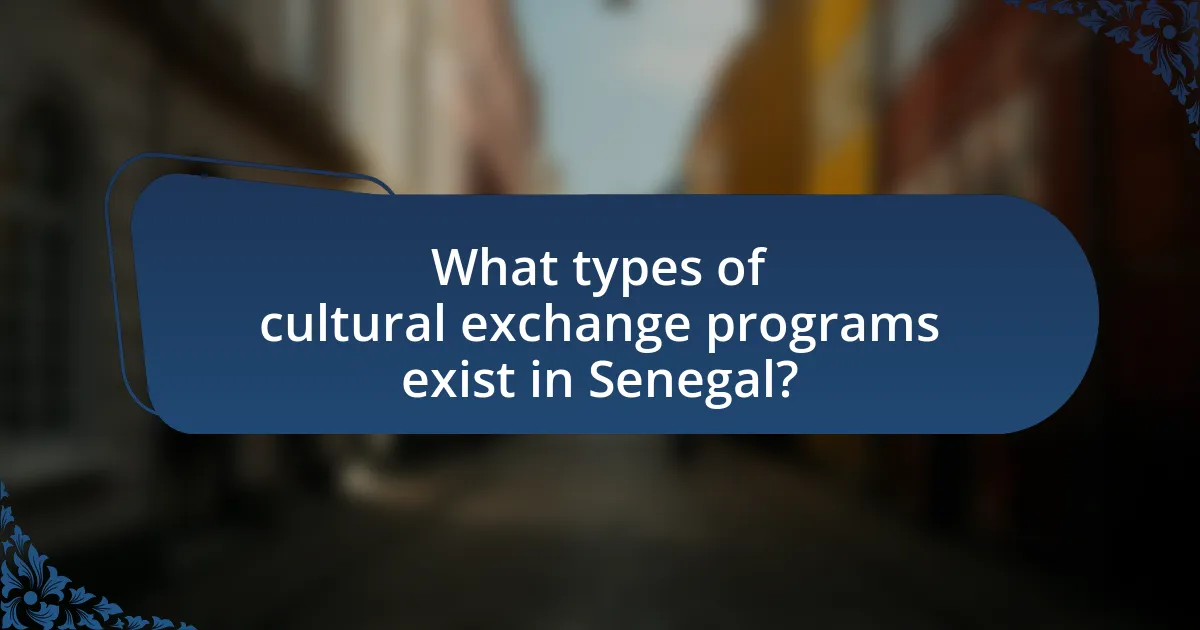
What types of cultural exchange programs exist in Senegal?
Cultural exchange programs in Senegal include artist residencies, educational exchanges, and community development initiatives. Artist residencies allow international artists to collaborate with local Senegalese artists, fostering creativity and cultural dialogue. Educational exchanges involve partnerships between Senegalese institutions and foreign universities, promoting academic collaboration and cultural understanding. Community development initiatives focus on cultural preservation and local engagement, often supported by NGOs and governmental organizations, enhancing the visibility of Senegal’s rich heritage. These programs collectively contribute to a deeper appreciation of Senegal’s diverse cultural landscape.
How do educational exchanges contribute to cultural understanding?
Educational exchanges significantly enhance cultural understanding by facilitating direct interactions between individuals from different backgrounds. These programs allow participants to immerse themselves in diverse cultural practices, languages, and perspectives, fostering empathy and reducing stereotypes. For instance, a study by the Institute of International Education found that 90% of students who participated in exchange programs reported a greater appreciation for cultural diversity. This firsthand experience promotes deeper connections and insights into the values and traditions of other cultures, ultimately leading to a more nuanced understanding of global citizenship.
What are the benefits of student exchange programs for Senegalese youth?
Student exchange programs provide Senegalese youth with enhanced educational opportunities, cultural exposure, and personal development. These programs allow students to experience different educational systems, which can improve their academic skills and broaden their perspectives. For instance, participating in exchange programs can lead to increased language proficiency, as students immerse themselves in environments where they practice foreign languages daily. Additionally, cultural exchange fosters understanding and appreciation of diverse cultures, which is crucial in a globalized world. Research indicates that students who engage in such programs often develop greater adaptability and intercultural communication skills, essential traits in today’s job market. Furthermore, these experiences can inspire Senegalese youth to contribute positively to their communities upon their return, leveraging the knowledge and skills gained abroad.
How do workshops and seminars facilitate cultural sharing?
Workshops and seminars facilitate cultural sharing by providing structured environments where participants can engage in dialogue, share experiences, and learn from one another. These settings encourage interaction among diverse groups, allowing individuals to present their cultural practices, traditions, and perspectives. For instance, in cultural exchange programs focused on Senegal’s heritage, workshops may include traditional music, dance, or culinary arts, enabling participants to experience and appreciate Senegalese culture firsthand. Research indicates that such interactive formats enhance understanding and foster respect for different cultures, as evidenced by studies showing increased cultural awareness and empathy among participants in similar programs.
What role do festivals and events play in cultural exchange?
Festivals and events serve as vital platforms for cultural exchange by facilitating interactions among diverse communities. They promote the sharing of traditions, art, and values, allowing participants to experience and appreciate different cultures firsthand. For instance, Senegal’s annual Dakar Biennale showcases local artists and attracts international visitors, fostering dialogue and collaboration across cultural boundaries. This exchange enhances mutual understanding and respect, contributing to a more interconnected global community.
How do international festivals highlight Senegal’s heritage?
International festivals highlight Senegal’s heritage by showcasing its rich cultural traditions, music, dance, and art to a global audience. These festivals, such as the Dakar Biennale and the Festival International de Jazz de Dakar, serve as platforms for Senegalese artists to present their work, thereby promoting traditional practices like Sabar dance and Griot storytelling. The participation of international artists and audiences fosters cultural exchange, enhancing the visibility of Senegal’s unique identity. Additionally, these events often feature local cuisine and crafts, further emphasizing the country’s diverse cultural landscape and historical narratives, which are integral to Senegal’s heritage.
What are some notable cultural events that promote exchange?
Notable cultural events that promote exchange include the Dakar Biennale, which showcases contemporary African art and fosters international collaboration among artists. Additionally, the Festival International de Jazz de Dakar brings together musicians from various countries, enhancing cultural dialogue through music. The Gorée Diaspora Festival celebrates the historical connections between Senegal and the African diaspora, facilitating discussions on heritage and identity. These events not only highlight Senegal’s rich cultural heritage but also encourage global participation and understanding.
How can individuals participate in Senegal’s cultural exchange programs?
Individuals can participate in Senegal’s cultural exchange programs by applying through organizations that facilitate these exchanges, such as the Senegalese Ministry of Culture or various non-governmental organizations focused on cultural diplomacy. These programs often require interested individuals to submit an application detailing their background, interests, and objectives for participating.
For example, the Senegalese Ministry of Culture has established partnerships with international institutions to promote cultural exchange, providing opportunities for individuals to engage in artistic residencies, workshops, and community projects that highlight Senegal’s rich heritage. Additionally, many programs offer scholarships or funding to support participants, making it accessible for a diverse range of individuals.
What opportunities are available for international participants?
International participants in Senegal’s cultural exchange programs have opportunities to engage in immersive experiences that highlight the country’s rich heritage. These programs often include workshops in traditional crafts, music, and dance, allowing participants to learn directly from local artisans and performers. Additionally, participants can take part in community service projects that promote cultural preservation and sustainability, fostering deeper connections with local communities. Research indicates that such exchanges enhance cross-cultural understanding and provide participants with unique insights into Senegalese traditions and practices.
How can volunteers contribute to cultural exchange initiatives?
Volunteers can contribute to cultural exchange initiatives by facilitating interactions between diverse cultural groups, thereby enhancing mutual understanding and appreciation. They can organize workshops, cultural events, and language exchanges that showcase Senegal’s heritage, such as traditional music, dance, and cuisine. For instance, volunteers can lead cooking classes that teach participants about Senegalese dishes, fostering a deeper connection to the culture. Additionally, research indicates that volunteer-led programs often result in increased cultural awareness and community engagement, as seen in various successful initiatives worldwide.
What are the requirements for participating in exchange programs?
To participate in exchange programs, individuals typically need to meet specific eligibility criteria, which often include being enrolled in an educational institution, maintaining a minimum GPA, and demonstrating proficiency in the language of the host country. Additionally, applicants may be required to submit letters of recommendation, a personal statement, and proof of financial support. These requirements ensure that participants are academically prepared and capable of adapting to a new cultural environment, which is essential for the success of the exchange experience.
What best practices should participants follow for effective engagement?
Participants should actively listen and contribute thoughtfully to discussions for effective engagement. Active listening fosters understanding and respect among participants, while thoughtful contributions enhance the quality of dialogue. Research indicates that effective engagement in cultural exchange programs, such as those showcasing Senegal’s heritage, relies on mutual respect and open communication, which are essential for building meaningful connections and promoting cultural appreciation.
How can participants ensure respectful cultural interactions?
Participants can ensure respectful cultural interactions by actively engaging in cultural sensitivity training and demonstrating openness to learning about different cultural practices. This approach fosters understanding and appreciation of diverse perspectives, which is essential in cultural exchange programs. Research indicates that cultural sensitivity training enhances participants’ awareness of their own biases and promotes respectful communication, leading to more meaningful interactions. For instance, a study by the University of Minnesota found that participants who underwent cultural sensitivity training reported increased empathy and reduced cultural misunderstandings during exchanges.
What strategies can enhance the experience of cultural exchange in Senegal?
To enhance the experience of cultural exchange in Senegal, implementing immersive programs that focus on local traditions, languages, and community involvement is essential. These programs can include workshops on traditional crafts, cooking classes featuring Senegalese cuisine, and language courses that teach Wolof or French, which are integral to the culture.
Research indicates that participants in immersive cultural experiences report higher satisfaction and deeper understanding of the host culture. For instance, a study by the University of California found that cultural immersion significantly increases participants’ appreciation for local customs and fosters meaningful connections with community members. By prioritizing these strategies, cultural exchange programs in Senegal can create more enriching and impactful experiences for all involved.
